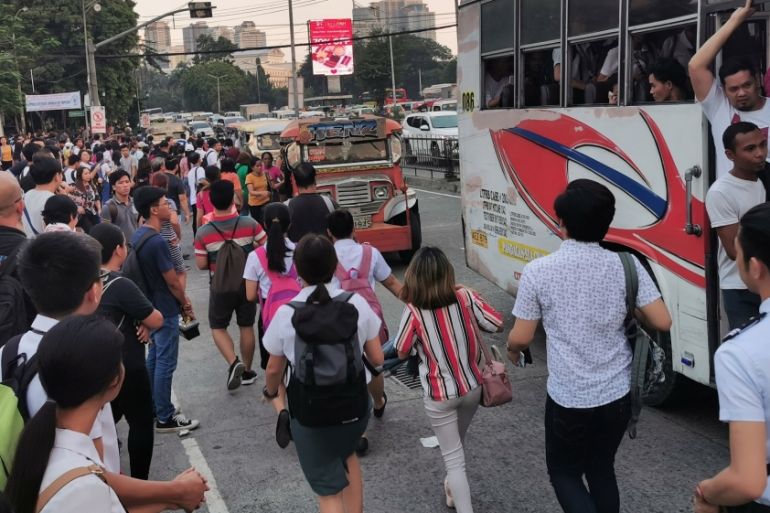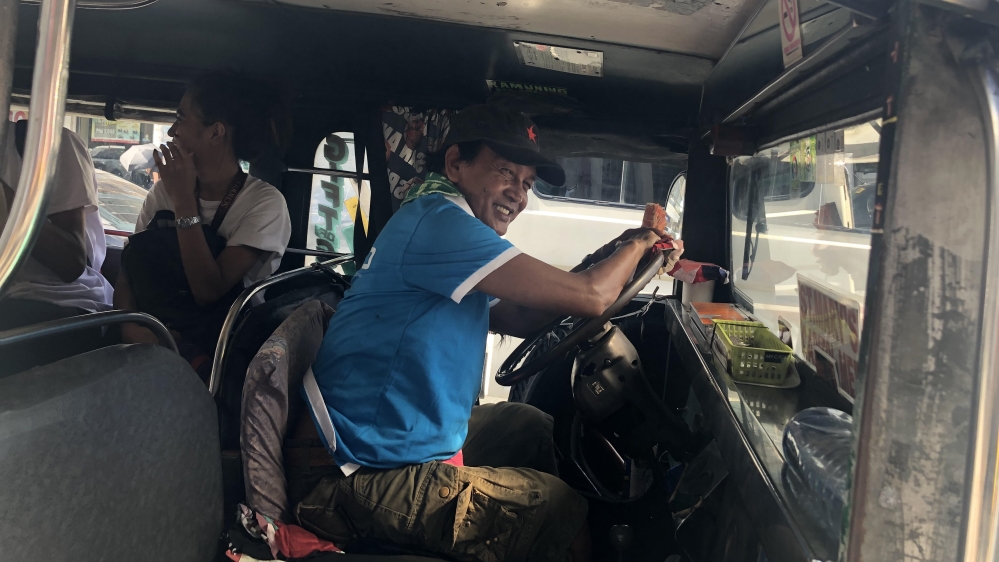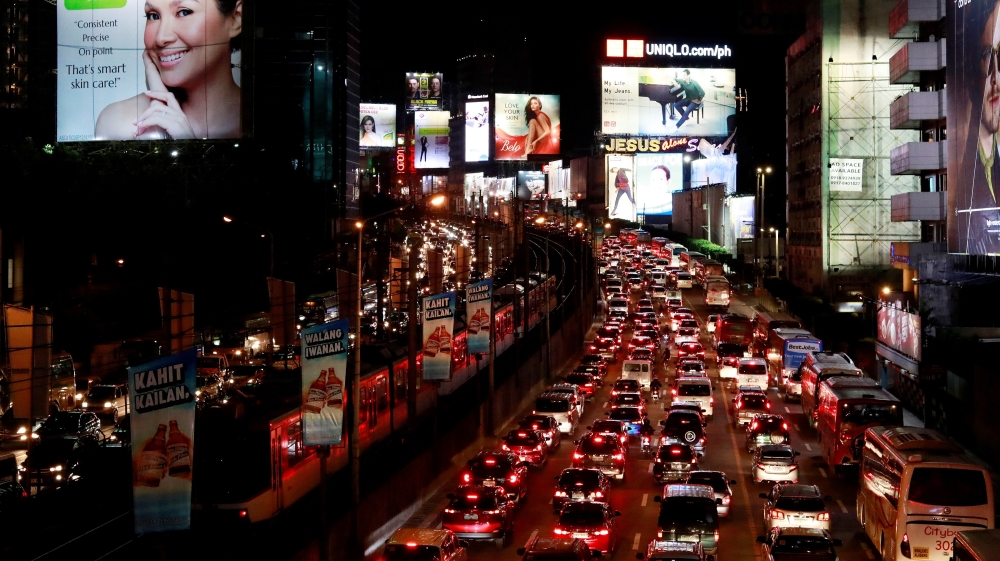Carmageddon: The indignity of commuting in Metro Manila
Most trips in Manila are made by public transport commuters but precedence is given to private vehicles.

Manila, Philippines – In his book, Inferno, best-selling author Dan Brown described the city of Manila as the gates of hell; a place where six-hour traffic jams and suffocating pollution reduced citizens to their most basic survival instincts.
To Metro Manila’s 13 million residents, it is “Carmageddon”, a portmanteau of car and Armageddon, the biblical place where good and evil are destined to have their last battle.
It is interesting that both phrases conjure visions of the end of the world.
|
|
Metro Manila in the Philippines is a cluster of 16 cities tenuously fused by a winding 23.8-kilometre (14.98-mile) highway called EDSA, the city’s main artery.
Pockmarked with crumbling infrastructure and creaking trains that move at a snail’s pace, Metro Manila is one of the most densely populated cities in the world where getting anywhere can take a minimum of one-and-a-half to two hours.
When the monsoon rains arrive, it takes even longer as the streets along the EDSA turn into pools of water.
Traffic in Metro Manila is also a killer. Literally.
Patients die in ambulances that cannot get to the hospital on time.
Romances fizzle out before they can even start because who wants to travel for two hours to go on a second date?

The hours spent in a vehicle that is not moving make you wonder if this is what it is like to die a slow death.
Billions in lost productivity
According to a study by the Boston Consulting Group, Filipinos spend about 16 days a year stuck in traffic, costing them about 100,000 Philippine pesos ($2,000) a year in lost income.
The Japan International Cooperation Agency pegs the cost of lost productivity at about 3.5bn pesos ($68m) a day. That is about $24.8bn a year.
|
|
But traffic congestion statistics alone cannot give you a picture of what commuting in Metro Manila is like, where the comfort of pedestrians is a mere afterthought in road design and urban planning.
Public transport makes up three-quarters of the total trips taken in Metro Manila but most of the space on roads is taken up by private vehicles.
This month the president’s spokesman Salvador Panelo said that there was no transport crisis in Philippine capital and people should just leave earlier if they wanted to get to work on time.
This triggered a public outcry. So I decided to see the situation for myself and take public transport the old-fashioned way, without using a ride-sharing app or hailing a cab.
I hopped on and off a series of public-transport vehicles to get from my interviews in Quezon City in the north to another appointment in Pasay in the south of Metro Manila.

My destination was about 15km (9.3 miles) away. My navigation app told me the trip would need three ride changes and would take about one hour and 43 minutes. It was 2pm (06:00 GMT) before rush hour began.
I jumped into a jeepney, the country’s ubiquitous and colourful minibus. The driver, a jolly man named Freddy told me he had been driving for 40 years, and made me guess his age.
He flashed his licence to show me that he was now 62 years old. He told me that he was still lucky to take routes along wider streets where the traffic was not that bad. The pleasant conversation made the humidity and smog, which made it feel like I was in a steam room, a little easier to bear.
2/2 “Traffic congestion is a symptom. The better question to ask (instead of how do we lessen cars) is how do we improve #mobility,” @iracruz of #AltMobility, who is working with legislators on a Commuter Rights Bill. My report on Al Jazeera coming up. #transportcrisis pic.twitter.com/GhSKbIRJhO
— Ana P. Santos (@iamAnaSantos) October 22, 2019
Mad scramble in the streets
Then I had to zigzag to the train station along the slivers of pavement that passed off as sidewalks. It reminded me of the vlog that fellow journalist Ralf Rivas made when he decided to walk from his house to a press event 12km (7.4miles) away.
At the platform waiting for the train, a rope barrier keeps you at a safe distance from the tracks as a mass of jostling commuters builds on the platform.
I arrived at the platform before rush hour, so it was not too bad. But I still waited for 10 minutes for the train to arrive. My train crawled along the tracks, but at least the air-conditioning was working and it didn’t break down somewhere in the middle of the ride, which is known to happen.
|
|
On my third and final leg, I had to wait for a jeepney or bus.
There was no bus stop where people could line up or wait comfortably. It was a free-for-all scramble.
Cabs and jeeps filled the streets as they waited for passengers to get in. Every passenger counts and the jeeps wait until they are full before they move off, or a traffic policeman shoos them away.
At peak times, this laissez-faire system turns into a mad rush.
I arrived at my destination at 3:52pm. Almost two hours after I had first set out.
I was wearing clothes made for public transport: jeans, trainers and a t-shirt but I was covered with a thick sheen of sweat that made my hair stick to the back of my neck and my clothes feel heavier. I was a little embarrassed to show up at a news conference looking a mess – and I imagined – rather smelly.
But it is about much more than that.
Unreliable trains and buses, the absence of bus stops where everyone can wait for a bus that will at some point – hopefully – show up, the pavements that are not wide enough to walk on, the grimy walkways that smell of urine mixed with smog make the commuting experience an affront to your dignity.
Commuter rights bill
That’s what Ira Cruz and his friends thought when he and his friends were sharing a pizza one night and decided to form AltMobility, a group of former government and private sector employees who were all tired of having to endure long commutes and wanted more humane transport options.
One of their members travelled for hours every day to get from his home to his office which was about 13km (eight miles) away. Cruz would take about an hour to travel seven kilometres (4.3 miles) to his office.

“All that time wasted. It’s not a life you want to live,” Cruz told me.
AltMobility helped draft the Commuter Rights Bill or the Magna Carta for dignified commuting in Metro Manila. Provisions in the bill include making the streets more pedestrian-friendly.
“Traffic congestion is a symptom. Instead of (only) thinking of how to lessen cars on the road, we need to ask: how do we improve mobility?” Cruz explained.
“If we make sidewalks less hostile, we will have more people choosing to walk. If we had better public transport, people would use less cars like they do in the big cities like New York, Hong Kong or Japan,” said Cruz.
There are at least five proposed laws to solve Metro Manila’s traffic pending in Congress.
|
|
The provisions proposed in the bill certainly sound better than the government’s suggestions – allowing only certain car types to use the road on certain days or closing off entire highways and making them one-way during rush hour – to ease traffic congestion.
For most residents, the proposed solutions to Manila’s transport problems are haphazard and ludicrous. “It’s like saying I should learn to levitate so I can zoom through traffic,” a friend told me.
“I’ll wait for the next tech genius to invent a ride-sharing app that will have an option for a flying carpet,” I countered, trying to outdo one ridiculous suggestion with another.
Urban planner Jun Palafox said that he had predicted this traffic crisis 43 years ago and that the current catastrophe was a result of years of government inaction.
Let’s hope legislators will move quickly to pass the commuter law.
The biggest tragedy would be for the flying carpet to become a reality sooner than the realisation of an efficient public transport system.